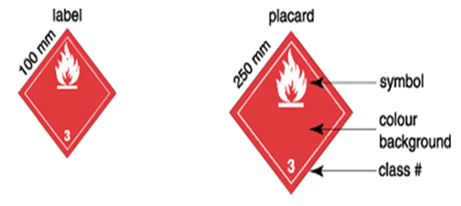When Are Placards Required In Canada?
A placard is a dangerous goods safety mark that is displayed on a large means of containment (MOC). It is used to identify dangerous goods and to show the nature of the danger they pose.
There is so much confusion around when placards are required in Canada so we have put together some Q&As to help understand Transport Canada’s requirements.
What safety marks are required on a Small Means of Containment (capacity 450L or less)?
Which labels or placard must be displayed depends on the classification of the dangerous good. The requirements for the display of the dangerous goods safety marks also depend on:
- size of the means of containment (e.g., small vs. large).
- The size (i.e., capacity) of the means of containment itself also determines whether a label or placard is required. Note that the amount of the good inside a means of containment may not be relevant.
- type of containers
- classification (primary and subsidiary hazard classes)
- whether or not they are shipped under a TDG exemption
- type of safety mark
Labels and placards are diamond shaped (also referred to as “square on point”) and must be displayed as illustrated below.
Figure 1: Label and placard (Image from Transport Canada)
When and How Must a Placard be Displayed?
As per Section 4.15 of the TDG Regulations, the primary class placard for each dangerous good contained in a large means of containment must be displayed on each side and on each end of the large means of containment. Each placard only needs to be displayed once on each side and each end regardless of how many products in the large means of containment correspond to that class (primary or subsidiary).
For example, if a vehicle is transporting UN1833, SULFUROUS ACID (Class 8) and UN1836, THIONYL CHLORIDE (Class 8), only one Class 8, placard is required to be displayed on each side and on each end of the vehicle.
A subsidiary class placard is required to be displayed on a large means of containment for dangerous goods that requires an emergency response assistance plan (ERAP) if they are included in one of the following subsidiary class:
- Class 1, Explosives;
- Class 4.3, Water-Reactive Substances;
- Class 6.1, Toxic Substances, Packing Group I due to toxic inhalation toxicity; or
- Class 8, Corrosives and are UN2977 or UN2978.
The subsidiary class placard must be displayed next to the primary class placard on each side and on each end of the large means of containment:
Note: A placard must NOT be displayed at a 45-degree angle on a truck frame or a supporting frame for the means of containment; it must remain as a square on point. Otherwise, it does not comply with the TDG Regulations.
Do Other Safety Marks Need to be Displayed on a Large Means of Containment?
Aside from placards, a large means of containment must also display the UN number of the dangerous goods if:
- An ERAP is required; or
- It is a liquid or gas in direct contact with the large means of containment. For example, a highway tank transporting UN1203, Gasoline. The liquid (gasoline) is in contact with the tank (large means of containment).
The UN number must appear on the placard or on a rectangular orange panel, without the prefix “UN”, next to the placard (see image below).
When Can I Use the DANGER Placard?
The DANGER placard is optional. It may be displayed on a large means of containment instead of any other placard required by Section 4.15.1 of the TDG Regulations if two conditions are met:
- The large means of containment contains two or more dangerous goods that require different placards; and
- The dangerous goods loaded into the large means of containment are contained in two or more small means of containment.
However, there are exceptions to this rule. The DANGER placard cannot be displayed on a large means of containment if:
- The dangerous goods have a gross mass greater than 1,000 kg, are included in the same class and are offered for transport by one consignor;
- The dangerous goods require an emergency response assistance plan (ERAP);
- The dangerous goods are included in one of the following classes:
- Class 1, Explosives;
- Class 2.3, Toxic Gases;
- Class 4.3, Water-reactive Substances;
- Class 5.2, Organic Peroxides, Type B;
- Class 6.1, Toxic Substances (subject to Special Provision 23); and
- Class 7, Radioactive Materials, Category III – Yellow label.
Note: If a road or railway vehicle to be transported by vessel contains a flammable gas, the flammable gas placard (Class 2.1) must be displayed on the road or railway vehicle.
Can I Voluntarily Display Placards for Any Quantity of Dangerous Goods?
Despite the fact that a placarding exemption may be used, a person may voluntarily display a placard for any quantity of dangerous goods when they are transported in a road or railway vehicle if certain provisions of Part 4 are met. These provisions include:
- Section 4.2– Misleading Dangerous Goods Safety Marks;
- Section 4.6– Visibility, Legibility and Colour;
- Section 4.7– Labels and Placards: Size and Orientation;
- Subsection 4.9(2)– Removal or Change of Dangerous Goods Safety Marks;
- Section 4.14– Class 7, Radioactive Material;
- Section 4.15.1– Subsidiary Class Placards on a Large Means of Containment;
- Paragraphs 4.15.3(a) and (b)– Placards and UN Numbers on a Large Means of Containment; and
- Section 4.16.1– DANGER Placard.
All of the above provisions must be met in order to voluntarily display a placard.
SOURCE: https://tc.canada.ca/en/dangerous-goods/dangerous-goods-safety-marks



